Happy Holidays Forest County Residents!
Many Forest County community members know that Argonne was once known as North Crandon, but few recall the reason for the switch and when the event occurred. According to the recollections of C.H. Marshall the town changed its name in 1921 due to the constant confusion at the post office with the names being so similar. Another factor around 1914 was the petition of a powerful figure in the town, Mr. Mausbaum, who promised to invest a great deal of money into the North Crandon if the town was renamed after his famiy. The board at the time did agree to change the name to Mausbaum, although the votes were very close. The town board agreed to announce the change in two local newspapers for three weeks but that was never done so the new name was not adopted. A few years later the Commerical Men’s Club decided to initiate a naming contest including all the school children. The name Argonne was finally chosen in honor of one of the club member’s sons dying in the Argonne Forest in France during WWI. Although some claim the name was chosen because the Military Road runs through this area. On July 4th of 1921, the townspeople of Argonne made a grand spectacle out of the name changing ceremony. They took the old town sign down and put it in a coffin and had six early settlers act as pall-bearers to carry the sign to its final resting place. It was escorted by a marching band to the area across from what is now Kathy’s bar where they burned and buried the sign. A great speech was given by Ward Wescott, a Crandon lawyer, to mark the momentous occasion. From hence forth the town was known as Argonne.

















